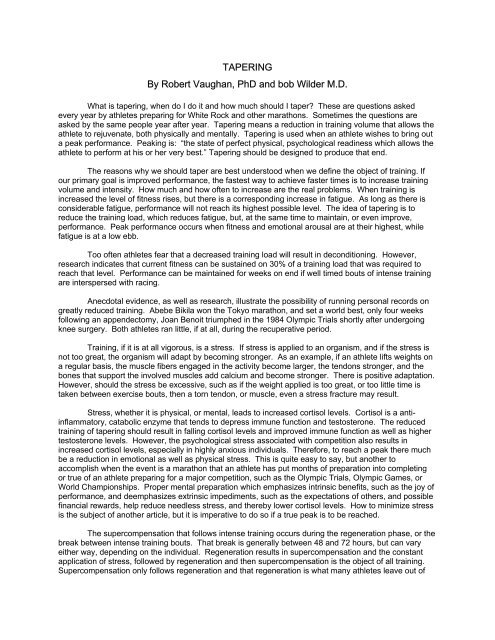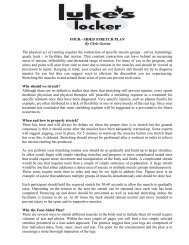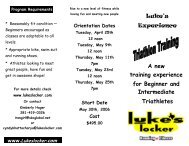TAPERING By Robert Vaughan, PhD and bob Wilder M.D.
TAPERING By Robert Vaughan, PhD and bob Wilder M.D.
TAPERING By Robert Vaughan, PhD and bob Wilder M.D.
You also want an ePaper? Increase the reach of your titles
YUMPU automatically turns print PDFs into web optimized ePapers that Google loves.
<strong>TAPERING</strong><br />
<strong>By</strong> <strong>Robert</strong> <strong>Vaughan</strong>, <strong>PhD</strong> <strong>and</strong> <strong>bob</strong> <strong>Wilder</strong> M.D.<br />
What is tapering, when do I do it <strong>and</strong> how much should I taper? These are questions asked<br />
every year by athletes preparing for White Rock <strong>and</strong> other marathons. Sometimes the questions are<br />
asked by the same people year after year. Tapering means a reduction in training volume that allows the<br />
athlete to rejuvenate, both physically <strong>and</strong> mentally. Tapering is used when an athlete wishes to bring out<br />
a peak performance. Peaking is: “the state of perfect physical, psychological readiness which allows the<br />
athlete to perform at his or her very best.” Tapering should be designed to produce that end.<br />
The reasons why we should taper are best understood when we define the object of training. If<br />
our primary goal is improved performance, the fastest way to achieve faster times is to increase training<br />
volume <strong>and</strong> intensity. How much <strong>and</strong> how often to increase are the real problems. When training is<br />
increased the level of fitness rises, but there is a corresponding increase in fatigue. As long as there is<br />
considerable fatigue, performance will not reach its highest possible level. The idea of tapering is to<br />
reduce the training load, which reduces fatigue, but, at the same time to maintain, or even improve,<br />
performance. Peak performance occurs when fitness <strong>and</strong> emotional arousal are at their highest, while<br />
fatigue is at a low ebb.<br />
Too often athletes fear that a decreased training load will result in deconditioning. However,<br />
research indicates that current fitness can be sustained on 30% of a training load that was required to<br />
reach that level. Performance can be maintained for weeks on end if well timed bouts of intense training<br />
are interspersed with racing.<br />
Anecdotal evidence, as well as research, illustrate the possibility of running personal records on<br />
greatly reduced training. Abebe Bikila won the Tokyo marathon, <strong>and</strong> set a world best, only four weeks<br />
following an appendectomy, Joan Benoit triumphed in the 1984 Olympic Trials shortly after undergoing<br />
knee surgery. Both athletes ran little, if at all, during the recuperative period.<br />
Training, if it is at all vigorous, is a stress. If stress is applied to an organism, <strong>and</strong> if the stress is<br />
not too great, the organism will adapt by becoming stronger. As an example, if an athlete lifts weights on<br />
a regular basis, the muscle fibers engaged in the activity become larger, the tendons stronger, <strong>and</strong> the<br />
bones that support the involved muscles add calcium <strong>and</strong> become stronger. There is positive adaptation.<br />
However, should the stress be excessive, such as if the weight applied is too great, or too little time is<br />
taken between exercise bouts, then a torn tendon, or muscle, even a stress fracture may result.<br />
Stress, whether it is physical, or mental, leads to increased cortisol levels. Cortisol is a antiinflammatory,<br />
catabolic enzyme that tends to depress immune function <strong>and</strong> testosterone. The reduced<br />
training of tapering should result in falling cortisol levels <strong>and</strong> improved immune function as well as higher<br />
testosterone levels. However, the psychological stress associated with competition also results in<br />
increased cortisol levels, especially in highly anxious individuals. Therefore, to reach a peak there much<br />
be a reduction in emotional as well as physical stress. This is quite easy to say, but another to<br />
accomplish when the event is a marathon that an athlete has put months of preparation into completing<br />
or true of an athlete preparing for a major competition, such as the Olympic Trials, Olympic Games, or<br />
World Championships. Proper mental preparation which emphasizes intrinsic benefits, such as the joy of<br />
performance, <strong>and</strong> deemphasizes extrinsic impediments, such as the expectations of others, <strong>and</strong> possible<br />
financial rewards, help reduce needless stress, <strong>and</strong> thereby lower cortisol levels. How to minimize stress<br />
is the subject of another article, but it is imperative to do so if a true peak is to be reached.<br />
The supercompensation that follows intense training occurs during the regeneration phase, or the<br />
break between intense training bouts. That break is generally between 48 <strong>and</strong> 72 hours, but can vary<br />
either way, depending on the individual. Regeneration results in supercompensation <strong>and</strong> the constant<br />
application of stress, followed by regeneration <strong>and</strong> then supercompensation is the object of all training.<br />
Supercompensation only follows regeneration <strong>and</strong> that regeneration is what many athletes leave out of
the equation. When the regeneration phase is ignored, fatigue increases to the point of overtraining or<br />
chronic fatigue.<br />
Fatigue, which limits performance in endurance events, is for the most part peripheral in nature.<br />
<strong>By</strong> peripheral we mean fatigue occurs in the muscles involved in the activity. The muscles engaged in<br />
long term, repetitive activity become depleted of glycogen <strong>and</strong> unable to produce the force required to<br />
maintain speed in long term aerobic activities, such as marathon <strong>and</strong> triathlon.<br />
In addition, there is a central component to fatigue. As an example: during intense, long term<br />
activity; such as running, or training for a marathon, blood glucose levels decrease <strong>and</strong> the glucose<br />
supply to the brain is diminished. Since glucose is the only fuel used by the brain, its depletion leads to<br />
muddled thought processes, clumsiness, <strong>and</strong> incoordination; the central nervous system responds less<br />
rapidly to stimulation.<br />
Fatigue in medium-duration, aerobic events such as 5000 <strong>and</strong> 10000 results from a gradual<br />
accumulation of hydrogen ions within the cell. The increased acidity causes impaired cell function, <strong>and</strong>,<br />
as with depleted energy stores, an inability to maintain the required speed. In short, middle distances,<br />
such as 800 <strong>and</strong> 1500 meters, the buildup of hydrogen ions within the cell is much more rapid, due to the<br />
intensity of the pace. No matter what the cause of fatigue, sufficient time should be given to allow<br />
regeneration <strong>and</strong> supercompensation to take place.<br />
The amount of time necessary to allow for regeneration varies from individual to individual.<br />
Research by Costill indicates that four weeks of reduced swim training by 70% will lead to no decrease in<br />
VO2 max, <strong>and</strong> no increase in lactate levels. A suggested reduction, over three weeks, of 30,50, 75% of<br />
training volume will produce excellent results just as long as a modicum of intense training is included<br />
every 72 hours. During the last week it is virtually impossible to do too little<br />
All endurance events, from 800 meters to the marathon benefit from intelligent rest <strong>and</strong><br />
regeneration. The peak results from proper application of hard work, <strong>and</strong> the intelligent removal of the<br />
training stimulus at the correct time, so that mental <strong>and</strong> physical energy reaches a peak at the same time.









